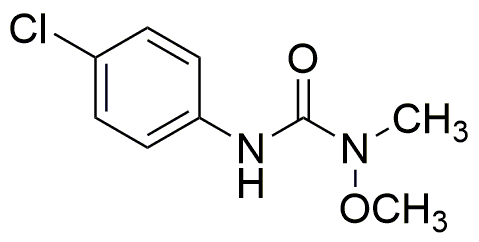Monolinuron is widely utilized in research focused on:
- Agriculture: As a herbicide, it effectively controls a variety of weeds in crops, enhancing yield and productivity for farmers.
- Environmental Studies: Researchers use it to study the degradation and environmental impact of herbicides, helping to develop safer agricultural practices.
- Plant Physiology: It serves as a tool in experiments to understand plant responses to herbicides, aiding in the development of resistant crop varieties.
- Food Safety: Monolinuron is analyzed in food products to ensure compliance with safety regulations, protecting consumer health.
- Pharmaceutical Research: Its chemical properties are explored for potential applications in drug formulation, particularly in targeting specific biological pathways.
General Information
Properties
Safety and Regulations
Applications
Monolinuron is widely utilized in research focused on:
- Agriculture: As a herbicide, it effectively controls a variety of weeds in crops, enhancing yield and productivity for farmers.
- Environmental Studies: Researchers use it to study the degradation and environmental impact of herbicides, helping to develop safer agricultural practices.
- Plant Physiology: It serves as a tool in experiments to understand plant responses to herbicides, aiding in the development of resistant crop varieties.
- Food Safety: Monolinuron is analyzed in food products to ensure compliance with safety regulations, protecting consumer health.
- Pharmaceutical Research: Its chemical properties are explored for potential applications in drug formulation, particularly in targeting specific biological pathways.
Documents
Safety Data Sheets (SDS)
The SDS provides comprehensive safety information on handling, storage, and disposal of the product.
Product Specification (PS)
The PS provides a comprehensive breakdown of the product’s properties, including chemical composition, physical state, purity, and storage requirements. It also details acceptable quality ranges and the product's intended applications.
Certificates of Analysis (COA)
Search for Certificates of Analysis (COA) by entering the products Lot Number. Lot and Batch Numbers can be found on a product’s label following the words ‘Lot’ or ‘Batch’.
*Catalog Number
*Lot Number
Certificates Of Origin (COO)
This COO confirms the country where the product was manufactured, and also details the materials and components used in it and whether it is derived from natural, synthetic, or other specific sources. This certificate may be required for customs, trade, and regulatory compliance.
*Catalog Number
*Lot Number
Safety Data Sheets (SDS)
The SDS provides comprehensive safety information on handling, storage, and disposal of the product.
DownloadProduct Specification (PS)
The PS provides a comprehensive breakdown of the product’s properties, including chemical composition, physical state, purity, and storage requirements. It also details acceptable quality ranges and the product's intended applications.
DownloadCertificates of Analysis (COA)
Search for Certificates of Analysis (COA) by entering the products Lot Number. Lot and Batch Numbers can be found on a product’s label following the words ‘Lot’ or ‘Batch’.
*Catalog Number
*Lot Number
Certificates Of Origin (COO)
This COO confirms the country where the product was manufactured, and also details the materials and components used in it and whether it is derived from natural, synthetic, or other specific sources. This certificate may be required for customs, trade, and regulatory compliance.


